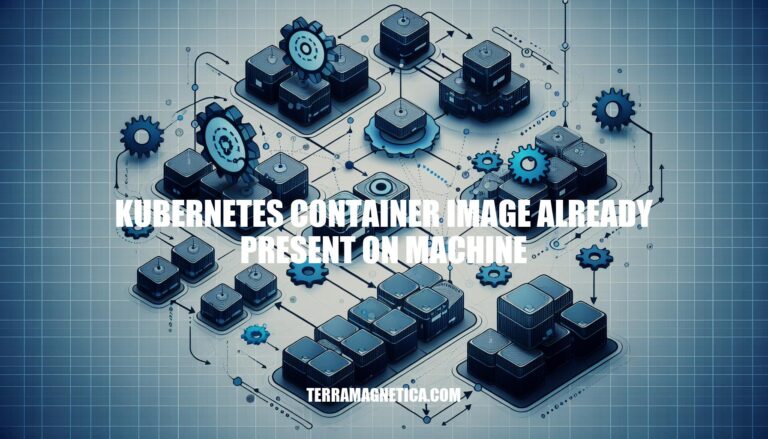


Have you ever encountered the message ‘Kubernetes container image already present on machine’ in your Kubernetes environment and wondered what it means? This common occurrence signals that the specified container image is already cached locally on the node where the pod is running. In this article, we will delve into the implications of this message and explore how you can troubleshoot and manage container images effectively in Kubernetes.
When encountering the message “Container image already present on machine” in a Kubernetes environment, it indicates that the specified container image is already cached locally on the node where the pod is running. Let’s explore some insights and potential solutions:
Image Caching Behavior:
Troubleshooting Steps:
targetPort).imagePullPolicy setting in your pod specification.Always, Kubernetes will always attempt to pull the image, even if it’s already present locally.Hope this helps!
Let’s explore how you can check existing container images using Docker and Kubectl.
Docker:
docker images
Kubectl:
kubectl.kubectl get pods --all-namespaces -o jsonpath="{..image}"
Remember that Docker is primarily for building, configuring, and distributing containers, while Kubernetes
Let’s delve into the benefits of reusing existing container images in container orchestration:
Resource Efficiency: Reusing container images reduces the need for redundant downloads and storage. When multiple services or applications share the same base image, it minimizes the overall resource footprint. This efficiency is crucial for large-scale deployments where resource utilization matters.
Faster Deployment: Existing container images are readily available, eliminating the time-consuming process of building images from scratch. By reusing pre-built images, you can deploy new services or updates swiftly, improving time-to-market.
Consistency and Predictability: When you reuse the same image across different environments (development, staging, production), you ensure consistency. This consistency leads to predictable behavior, reducing the chances of unexpected issues during deployment.
Security and Patch Management: Using well-maintained base images allows you to benefit from security patches and updates provided by the image maintainers. Regularly updating your base images ensures that your containers are protected against known vulnerabilities.
Version Control and Rollbacks: By reusing images, you can tag and version them. This makes it easier to track changes and roll back to a previous version if needed. Versioned images provide better control over your application’s lifecycle.
Dependency Management: Container orchestration platforms handle dependencies between services. When you reuse existing images, you avoid dealing with complex dependency chains manually. The orchestration system ensures that services start in the correct order.
Scalability: Reusing images simplifies scaling. When you need to scale your application horizontally (adding more instances), the orchestration platform can quickly spin up new containers based on the same image.
Testing and Debugging: Consistent images facilitate testing and debugging. Developers can work with the same image locally as in production, reducing the “it works on my machine” problem. Debugging issues becomes more straightforward when everyone uses identical images.
Reduced Build Time: Building an image from scratch involves compiling dependencies, installing packages, and configuring settings. Reusing existing images skips this step, significantly reducing build times during CI/CD pipelines.
Community and Ecosystem: Popular base images often have a vibrant community and ecosystem. You can find documentation, best practices, and troubleshooting tips readily available. Leveraging community-supported images saves time and fosters collaboration.
In summary, reusing existing container images streamlines development, enhances security, and promotes consistency across your containerized applications. Whether you’re using Kubernetes, Docker Swarm, or another orchestration tool, this practice remains beneficial for efficient and reliable container management.
Updating container images in Kubernetes is crucial for maintaining security, performance, and stability. Let’s explore some best practices:
Rolling Deployments:
Image Pull Policy:
imagePullPolicy and the image tag affect when Kubernetes attempts to pull the specified image.imagePullPolicy:
imagePullPolicy: Always reliable as long as the registry is accessible.Scan for Vulnerabilities:
Update Base Images and Application Runtime:
For more detailed information, you can refer to the official Kubernetes documentation on container images. Additionally, Microsoft Azure provides operator best practices for container image management in AKS .
Let’s explore how Docker and Kubernetes address common challenges related to container images.
Kubernetes is an open-source container orchestration platform that automates the deployment, scaling, and management of containerized applications. It provides a robust framework for running distributed systems resiliently, making it easier to deploy and operate applications in containers.
Kubernetes offers several benefits:
Container orchestration involves managing deployment, scaling, and coordination of containers across a cluster. Kubernetes simplifies this process by providing a declarative approach. Developers define the desired state using YAML or JSON files, and Kubernetes ensures the actual state matches the desired state.
In a containerized environment, services may dynamically create, scale, or move. Kubernetes addresses this challenge by providing built-in service discovery. Each service gets a unique IP address and DNS name, allowing other containers to discover and communicate with them.
Docker and Kubernetes complement each other to create a complete ecosystem for containerized development, deployment, and management. Here’s how they collaborate:
Docker: Used to package applications into containers. Docker provides tools for building, shipping, and running secure containers. Docker Hub, the largest container image repository, allows developers to store and share images, making deployment to Kubernetes clusters easier.
Kubernetes: Orchestrates containers, automating tasks like scaling, load balancing, and self-healing. Once applications are packaged into secure Docker containers, Kubernetes manages their deployment in production.
In summary, Docker and Kubernetes work harmoniously, empowering developers to streamline development, ensure security, and accelerate deployment of containerized applications
In conclusion, navigating the complexities of Kubernetes container images, especially when faced with messages like ‘Container image already present on machine,’ requires a blend of strategic handling and technical acumen. By understanding the caching behavior, troubleshooting steps, and best practices for updating and managing container images, you can ensure optimal performance and stability in your Kubernetes environment. Embracing efficient image reuse, implementing secure update strategies, and leveraging the powerful capabilities of Docker and Kubernetes in tandem will empower you to streamline your container orchestration workflows and drive success in your deployment scenarios.